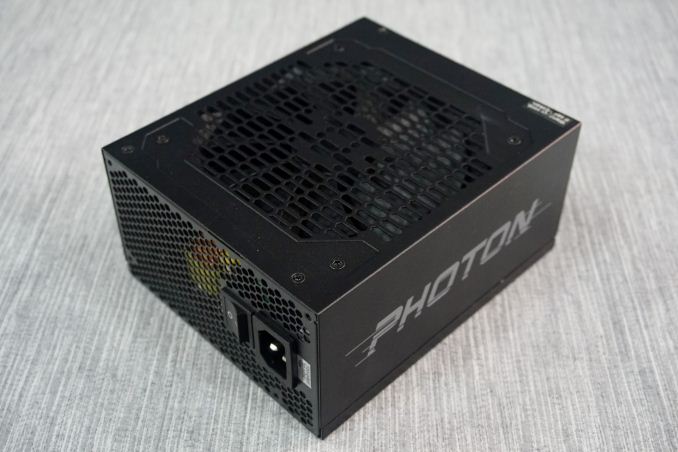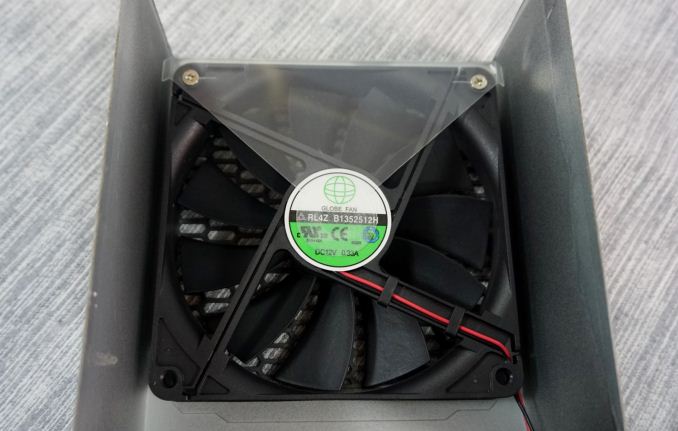The Rosewill Photon 1050W Review
by E. Fylladitakis on March 24, 2015 8:00 AM EST- Posted in
- Cases/Cooling/PSUs
- Rosewill
- 1050W
- Sirfa
External Appearance
The only thing that truly differentiates the Rosewill Photon from any other black PSU is the fan finger guard, which is not a separate part but an elongated honeycomb pattern punched on the steel chassis itself. Other than that, the series logo is printed on the right side of the chassis making it visible from a windowed side panel only if the PSU is installed with its fan facing upwards. There is absolutely nothing on the left side of the unit; the spectator will see only a plain, matte black surface from the side of a case if the unit is installed with its fan facing downwards. The sticker with the specifications of the PSU is found at the top side of the chassis.
Only the numerous connectors for the modular cables can be seen at the front of the chassis, with a basic printed legend indicating which connector corresponds to each cable. The CPU and PCI Express cables share the same connectors, while the split 10-14 pin connector is for the 24-pin ATX cable and the smaller connectors are for SATA/Molex cables.
Internal Design
A black 135mm fan from Globe is responsible for the cooling of the Photon 1050W. The B1352512H is a ball bearing fan with a maximum speed of 1500RPM, meaning that it can get significantly loud if the unit is heavily stressed. Of course, a thermal control circuitry adjusts the speed of the fan according to the load and the temperature of the unit, so we will examine how it truly behaves during our testing.
A look inside the Rosewill Photon 1050W instantly reveals that the OEM behind this unit is Sirfa, This is the same company who owns High Power as their own retail brand. Sirfa is not a bad OEM at all but it is not yet highly reputable among enthusiasts, mostly due to a few not-so-good low-cost designs they supplied through Sirtec in the past. The filtering stage is textbook, with four Y capacitors, two X capacitors and two filtering inductors. We also found a transient suppression diode and a classic fuse. There are two main rectifying bridges, sandwiched on a small, dedicated heatsink. Two large Nippon Chemi-Con 400V/390μF capacitors can be seen in the PFC stage, alongside an equally large filtering inductor. Two low resistance power transistors by Infineon form a half-bridge primary inversion stage, while eight transistors by the same company create the secondary conversion stage and generate the 12V output.
Quality wise, the Photon 1050W ranks above average, but it is not perfect. The quality of the components is outstanding; all of the main components come from reputable manufacturers - the electrolytic capacitors are all from Nippon Chemi-Con and the polymer capacitors are supplied by Fujitsu Electronics. Sirfa could improve their design and assembly quality a little though - the design is a little messy and there are several joints amateurishly soldered. These will not be a problem but they are also not something enthusiasts like to see in products that are supposed to compete in the high-end segment of the market.

























42 Comments
View All Comments
DanNeely - Tuesday, March 24, 2015 - link
Yup. And while I know loaned/donated hardware is the default for most reviews; in a roundup review, spending $30-60 for a single no-name model to show what spending a little more for a brand name model gives should be an acceptable use of editorial dollars. Two cheap models might be worth it as well; one obvious garbage box to be sacrificed on the alter of magic smoke, and a second that while expected to survive is a few steps down on the performance scale (eg bare 80plus). I wonder if you might be able to fiangle the latter out of one of the OEMs: "I want a baseline model to demonstrate why your 80+ gold model is worth the extra $20."chlamchowder - Wednesday, March 25, 2015 - link
If I may add one more thing, I have never once looked at a 1000W power supply and said "this unit performs well, so this brand's 400-600W units must be good too".When I went shopping for a PSU, I went for a $40 500W model with a plain 80+ rating because there were practically no reviews of sub-$100 400-600W units (and I didn't want a $20 no-name model that might have 45% efficiency). But if reviews showed that spending $100 gave a big improvement over lower priced units, I might have decided differently.
DanNeely - Tuesday, March 24, 2015 - link
The other half is that high efficiency PSUs only pay for themselves under largish 24/7 loads at typical US power prices. I played around with the numbers recently for my new build:For a 24/7 load (distributed computing), $0.12/kwh for electricity, modular designs only, and wanting ~200W headroom to keep the PSU fan from adding to the system noise; and over 6 years a 91% platinum PSU only broke even over an 88% gold unit if I ran SLI/xFire for about half the time. In a pure single GPU config the gold model barely broke even vs a cheaper silver model. I ended up going with the platinum model because I expect the 5k monitor I'm planning on buying in the next 12-24 months almost certainly will require SLI/xFire for a few years; combined with a housing situation where my landlord is responsible for the heating bill while air conditioning is on me tipping the scale.If your PC spends most of its day off/idle a high efficiency PSU isn't going to give much of a return except possibly at very high electricity rates. If an OEM ever makes one, a small 80+ titanium unit might be worthwhile for mainstream users just due to the large boost it requires at a 10% load.
JeffFlanagan - Tuesday, March 24, 2015 - link
Good point. Power requirements for PCs with massive storage have also come down quite a bit now that 3 2TB drives can be replaced with a single 6TB drive.bigboxes - Tuesday, March 24, 2015 - link
I have 8 hard drives (1 SDD for the OS) in my file server. If they increase the size I'll just get 8 6TB drives. Right now I'm slowly migrating to 4TB models (up from 1.5TB and 2TB models). Hard drives don't consume a lot of energy regardless.Gigaplex - Tuesday, March 24, 2015 - link
My home server has 5 hard drives (4x 3TB array plus the OS drive) and i'm using a 450W PSU. The system idles at 60W measured at the wall. It hits about 75W when the array is maxing out the gigabit network connection. The only time you really need to worry about power requirements for "massive storage" is during boot, but if you stagger the spin-up then it's not a problem. Not that I've had to bother with my current system.romrunning - Tuesday, March 24, 2015 - link
"The high ambient temperatures have a significant impact on the electrical performance of the Photon 1050W, reducing its energy conversion efficiency by an average of 2%. The drop is higher as the load increases, reaching a massive 3.7% drop with a load of 1050W."C'mon now, an increase from 2% to 3.7% is NOT a "massive" difference.
SirGCal - Tuesday, March 24, 2015 - link
You wouldn't be saying that if it was the APR % difference in your mortgage for example... If you were at 2% and they raised you to 3.7%, you'd @#$% the bed. Everything is perspective.romrunning - Tuesday, March 24, 2015 - link
C'mon now, don't conflate two items that are completely different. Changes in a mortgage APR don't equally equate into slight changes in a power supply's energy conversion efficiency.If two power supplies were being compared and one was 3.7% while the other was 5.0%, would you still describe the 3.7% variance as "massive"? How would you describe the 5.0% variance?
E.Fyll did a good job with his review; I just thought the word "massive" was a bit hyperbolic in the context used.
E.Fyll - Tuesday, March 24, 2015 - link
Actually, it is an 85% increase over the average efficiency drop. That, alongside the fact that everything above 1-1.5% for that particular test is very high, is pretty much massive.